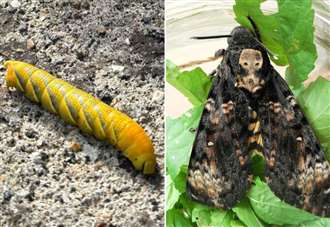A remarkable discovery in a Kent garden has captivated enthusiasts and experts alike, bringing to light one of nature’s most intriguing and elusive creatures. What initially appeared to be an unusually large caterpillar has since been identified as the larva of the rare death’s-head hawkmoth, a species steeped in both scientific fascination and popular culture lore.
This particular caterpillar, now drawing significant attention, is destined to transform into a mature Acherontia atropos, one of the three species comprising the genus Acherontia. Known for its imposing size, the adult moth can achieve a wingspan of almost five inches, making it a truly striking specimen within the insect world.
Beyond its impressive physical attributes, the death’s-head hawkmoth holds a distinct place in popular culture, largely due to its memorable appearance in the critically acclaimed 1991 thriller, “The Silence of the Lambs.” The moth’s chilling imagery was prominently featured on the film’s iconic promotional poster, becoming an enduring symbol of the movie’s dark and psychological themes.
In the cinematic narrative, the moth is intrinsically linked to the serial killer Buffalo Bill, embodying his disturbing obsession with metamorphosis and identity. This connection solidified the death’s-head hawkmoth’s status as a symbol of macabre fascination, bridging the gap between natural history and horror fiction.
Historically, the death’s-head hawkmoth has also been associated with various superstitions and folklore. Across different cultures, it has been widely regarded as an omen of death, misfortune, or even bad luck, a reputation likely fueled by the skull-like pattern visible on its thorax and its nocturnal habits.
Scientifically, the moth exhibits unique biological traits that further distinguish it. Unlike most other moth species, the adult death’s-head hawkmoth possesses the rare ability to emit an audible squeak when agitated or disturbed. This unusual sound is produced by forcing air through its proboscis, a remarkable adaptation that adds to its mystique.
The garden discovery of such a rare moth specimen in a Kent garden underscores the unexpected diversity of local Kent wildlife and highlights the importance of environmental awareness. It serves as a compelling reminder that extraordinary natural wonders can often be found in the most unassuming of places, inspiring both awe and further entomology inquiry into the intricate lives of these fascinating creatures.






Leave a Reply